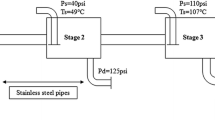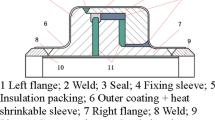Abstract
Failure of a ring type joint (RTJ) of reactor pipeline of a hydrocracker unit has been reported. Cracks were noticed on the flange as well as the ring gasket of the RTJ during inspection following a periodic shutdown of the unit. These components of the RTJ were manufactured from stabilized grades of austenitic stainless steel, namely, type 321 and 347, respectively. Study showed that the failure of the RTJ components occurred by transgranular stress corrosion cracking. It was further established that formation of polythionic acid due to presence of H2S in the process gas and H2O in the system was responsible for initiation of SCC in RTJ components. Detailed metallurgical investigation was carried out to identify the probable causes that could have been responsible for formation of polythionic acid in the process gas.










Similar content being viewed by others
References
G.R. Lobley, Stress corrosion cracking: Cases in refinery equipment. In: Environment-induced cracking of materials, Proceedings of 2nd International conference on environment-induced cracking of metals, Banff, Alta, 19–23 September, 2004, (Elsevier, Amsterdam, 2008), pp. 401–410
J. Gutzeit, R.D. Merrick, L.R. Scharfstein, Corrosion in petroleum refining and petrochemical operations. Metals Handbook, vol. 13: Corrosion, 9th edn. (American Society for Metals, Metals park, OH, 1987), pp. 1262–1287
H.H. Horowitz, Chemical studies of polythionic acid stress corrosion cracking. Corros. Sci. 23, 353–362 (1983)
H.M. Tawancy, Failure of hydrocracker heat exchanger tubes in an oil refinery by polythionic acid-stress corrosion cracking. Eng. Fail. Anal. 16, 2091–2097 (2009)
ASM. Failure Analysis and Prevention. Metals Handbook, vol. 10, 8th edn. (American Society for Metals, Metals park, OH, 1975), pp. 205–227
A.N. Delavar, M. Shayegani, A. Pasha, An investigation of cracking causes in an outlet RTJ flange in ISOMAX unit. Case Stud. Eng. Fail. Anal. 1, 61–66 (2013)
Acknowledgements
The authors gratefully acknowledge the contribution of M. Madan in sample preparation, metallography, and hardness measurements.
Author information
Authors and Affiliations
Corresponding author
Rights and permissions
About this article
Cite this article
Gore, P., Sujata, M. & Bhaumik, S.K. Stress Corrosion Cracking of Ring Type Joint of Reactor Pipeline of a Hydrocracker Unit. J Fail. Anal. and Preven. 14, 307–313 (2014). https://doi.org/10.1007/s11668-014-9820-8
Received:
Revised:
Published:
Issue Date:
DOI: https://doi.org/10.1007/s11668-014-9820-8




